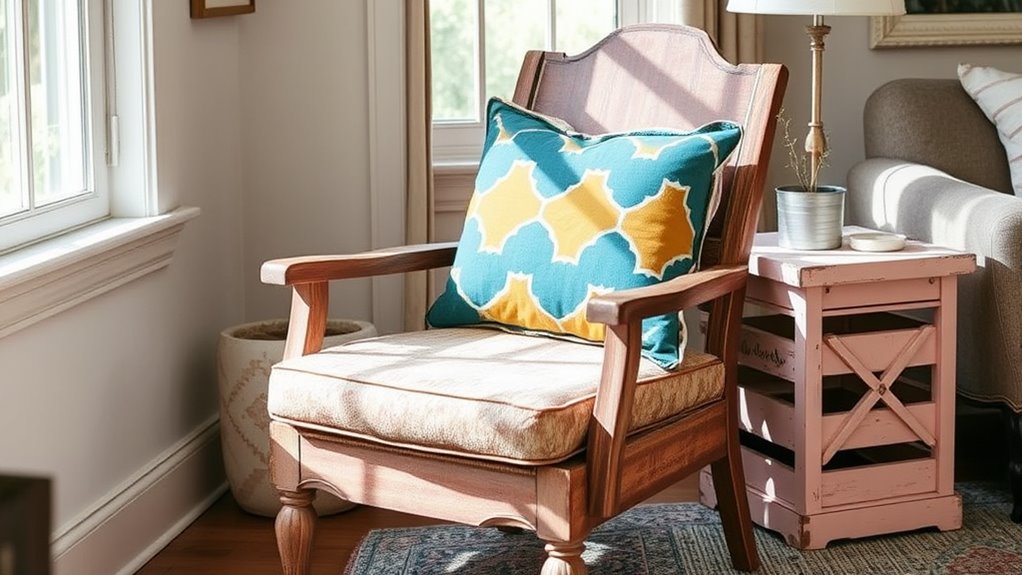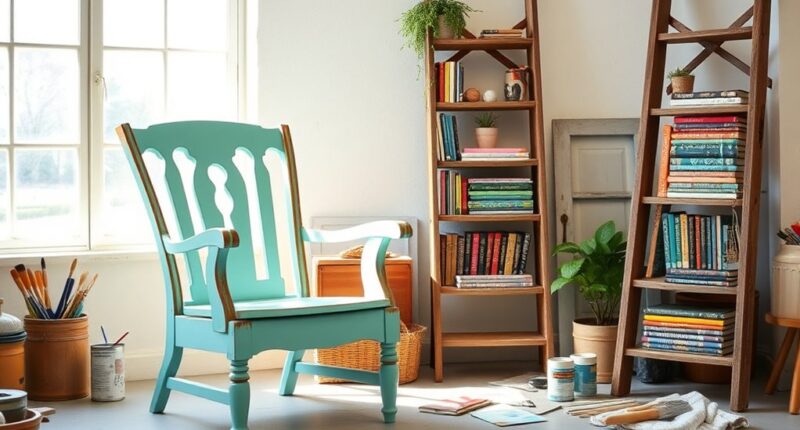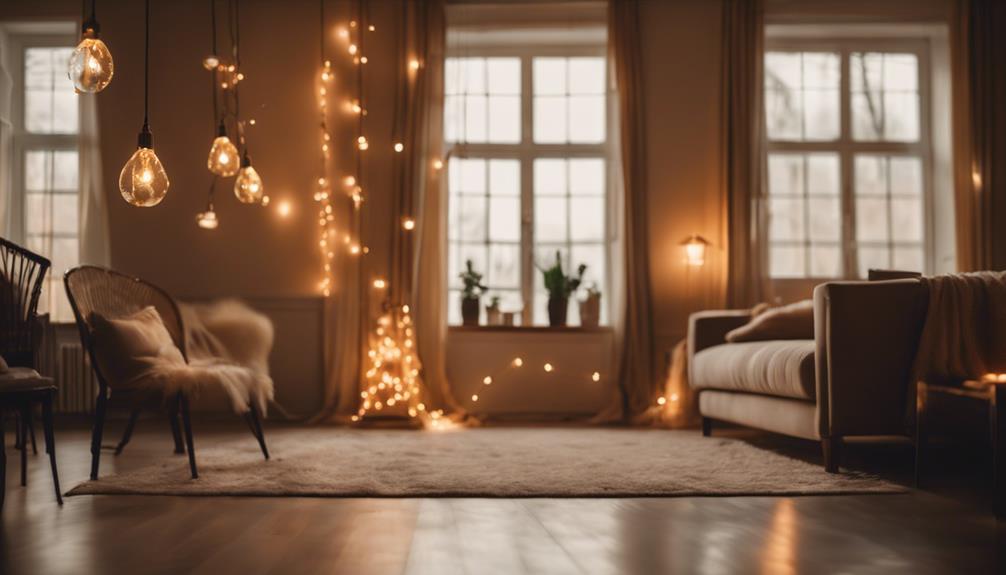Upcycling old furniture offers fun and creative ways to update your decor. Start by removing rust or old paint, then choose a fresh finish—like chalk paint or spray paint—to match your style. Sand surfaces, apply primer, and experiment with colors, patterns, or metallic accents for a personalized touch. Seal your work with wax or polyurethane to protect it. Keep exploring, and you’ll discover even more inspiring ideas to transform your space.
Key Takeaways
- Use rust removal techniques like vinegar mixtures and wire brushes to prepare furniture for painting.
- Experiment with various painting styles, such as chalk paint or spray paint, to achieve unique finishes.
- Properly sand and prime surfaces to enhance paint adhesion and ensure a smooth, durable finish.
- Select and mix colors thoughtfully to create bold contrasts, subtle pastels, or personalized designs.
- Seal painted furniture with wax or polyurethane to protect and maintain its revamped appearance.

Upcycling old furniture is a creative and sustainable way to breathe new life into pieces that might otherwise be discarded. When you decide to give an old chair or table a fresh look, the first step often involves rust removal. Rust can make furniture look neglected and diminish its structural integrity, but with the right techniques, you can restore its original charm. Start by using a rust remover or a mixture of vinegar and baking soda to loosen stubborn spots. For more stubborn areas, a wire brush or steel wool can be effective. Always wear gloves and work in a well-ventilated space to keep things safe. Once the rust is gone, you’ll notice the surface is ready for your creative paint techniques. Whether you prefer a distressed, shabby-chic style or a sleek, modern finish, your paint choices can dramatically transform the piece. Using chalk paint allows for easy blending and a matte finish that’s perfect for vintage looks, while spray paint can give a smooth, even coat for a contemporary vibe. You might also experiment with stencils, decorative patterns, or metallic accents to add a personalized touch. Layering different paint techniques can create depth and interest, making your furniture truly one-of-a-kind. Before applying paint, make sure to sand the surface lightly to guarantee the paint adheres well and lasts longer. Primer can also help achieve a more polished look and prevent bleed-through, especially when working with darker or uneven surfaces. Don’t be afraid to mix and match colors—sometimes, a bold contrasting hue or a subtle pastel can completely change the character of a piece. After the paint dries, consider adding a protective finish such as wax or polyurethane to seal your work and enhance durability, especially if the furniture will see regular use. Regular maintenance and understanding the refrigeration cycle can help ensure your furniture remains in good condition over time. Remember, upcycling is all about personal expression, so feel free to experiment with different techniques, colors, and textures until you find a look that resonates with your style. Whether you’re working on a vintage dresser, a worn-out coffee table, or a neglected bench, these steps will help you revive the piece with confidence. The process of rust removal and inventive paint techniques not only revitalizes furniture but also gives you a rewarding sense of accomplishment. With patience and creativity, you’ll discover that upcycling old furniture isn’t just a cost-effective solution—it’s an opportunity to craft something uniquely yours, adding character and charm to your home decor.
Frequently Asked Questions
What Tools Are Essential for Furniture Upcycling?
You’ll need essential tools like a good sander for sanding techniques, ensuring smooth surfaces and removing old paint or varnish. A variety of sandpaper grits helps achieve the desired finish. Don’t forget screwdrivers and pliers for hardware selection and replacement, along with brushes or rollers for applying paint or stain. A tape measure and clamps also come in handy. These tools make your upcycling project easier and more professional-looking.
How Do I Choose the Right Paint for My Project?
Choosing the right paint is like selecting the perfect song for a dance; it sets the mood. Pick a finish that matches your style—matte for soft elegance, glossy for shine, or satin for versatility. Consider your color palette carefully, aiming for hues that complement your space. Test small patches first to see how different finishes and colors look under your lighting, ensuring your revamped piece truly sings.
Can Upcycling Furniture Increase Its Value?
Yes, upcycling furniture can increase its resale value and boost your upcycling investment potential. When you revamp old pieces with creative techniques, you make them more appealing and unique, attracting buyers who want one-of-a-kind items. Properly upcycled furniture stands out in the resale market, often fetching higher prices. Plus, your craftsmanship adds to its worth, making your upcycling efforts a smart investment in both style and financial return.
What Are Eco-Friendly Upcycling Materials?
You can use eco-friendly upcycling materials like recycled fabric for upholstery or decorative accents, which reduces waste and adds a unique touch. Eco-friendly adhesives are great for bonding without harmful chemicals, ensuring your project stays green. These materials help you create beautiful, sustainable pieces that are kind to the environment. By choosing recycled fabric and eco-friendly adhesives, you turn old furniture into stylish, eco-conscious decor that’s both functional and environmentally responsible.
How Long Does a Typical Upcycling Project Take?
Most upcycling projects take between 2 to 10 hours, depending on complexity. You can cut down this time with good project planning and time management, breaking tasks into manageable steps. An interesting statistic shows that those who plan ahead spend 30% less time on DIY projects. So, if you allocate your time wisely and stay organized, you’ll finish your furniture revamp faster and enjoy your new decor sooner.
Conclusion
So, next time you stumble upon that old chair or dusty table, remember it’s more than just junk — it’s a chance. With a little paint, some imagination, and a dash of effort, you can breathe new life into your space. It’s funny how a simple upcycle can transform a room and brighten your day. Keep experimenting, stay creative, and watch your decor become uniquely yours, one piece at a time.









